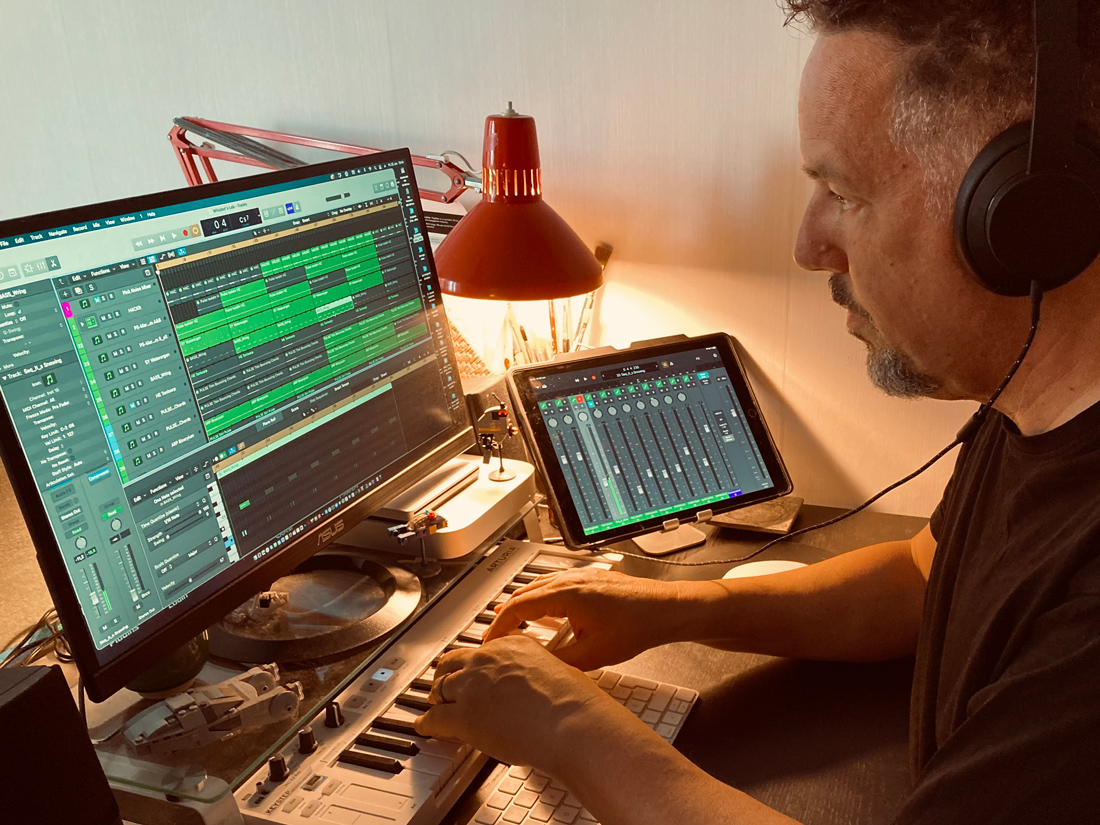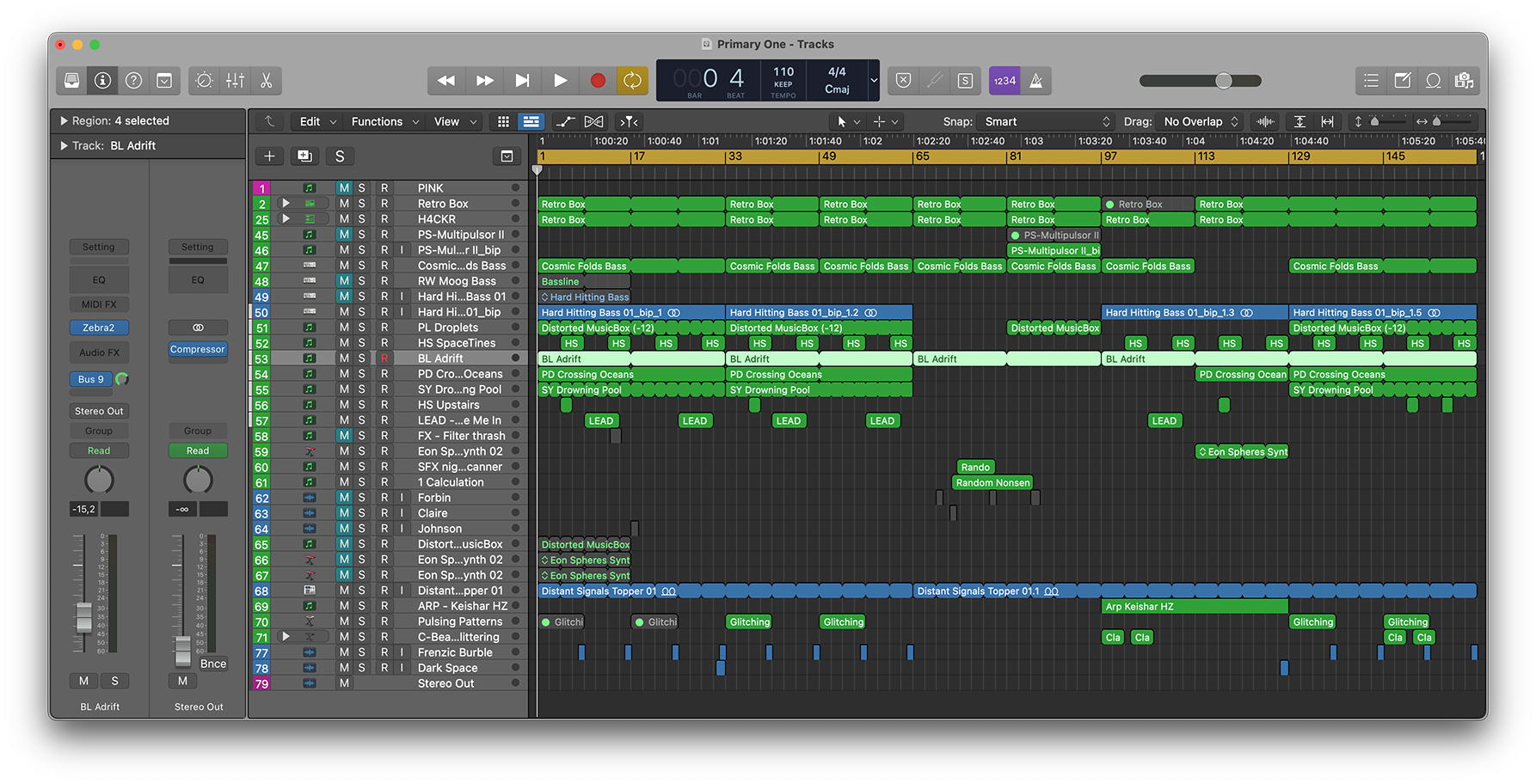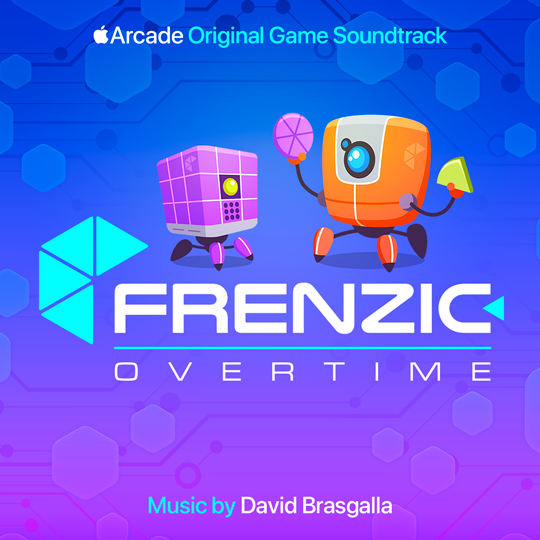
Frenzic: Overtime is the fast-paced sequel to the original game which first debuted thirteen years ago. Everything about this new title has been propelled far beyond the original – including the soundtrack music which is streaming now on Apple Music and Spotify.
When I created the original music for Frenzic, I’d been a casual GarageBand user for several years, and my construction method reflected that: I was mainly working with Apple Loops and one-shot WAV files. This was a perfectly workable solution at the time, but the use of standard libraries of loops and sounds meant I’d have to accept a certain generic flavour to the result. I’d certainly become adept at spotting those familiar loops in other musicians’ music, and I knew they would certainly hear them in mine in turn.
When I sat down to create the music for Frenzic: Overtime, I began with that same technique out of habit, this time using Logic Pro. As soon as I heard the results of my first experimentations, I knew I was going to have to push myself much farther this time. Logic Pro has an impressive array of loops available, but I wanted to find a unique sound for the game this time. I needed to compose!
Next Steps
My main desire was to evoke a lot of the classic synth sounds I grew up with in the 70’s and 80’s – artists like Kraftwerk, Gary Numan, Brian Eno, Depeche Mode, Vangelis, Tomita, and Wendy Carlos. This would be a way to pay tribute to all of them, and I’d probably never get a better opportunity. There was also a definite “kid in a candy store” element at work, as all of today’s great synth tools would have cost a substantial fortune back in the late 70’s/early 80’s, yet I can now obtain nearly anything at very affordable prices, or even free.

Setting to work, I decided to make the all of the various tracks be variations on my update of the original Frenzic theme music, and to see just how far I could twist and manipulate that theme. I created three pieces of music for each of the three major gameplay modes – one piece for each difficulty level therein. The tempo of each piece corresponds to the difficulty level: Easy/110, Medium/120 and Hard/130 beats per minute, so that the pace increased alongside the game challenge (WhizBot’s Lab is heard outside gameplay, and is intended to be relaxing for the user as they decide how to spend squarks and set up their powerups).
As I was creating the game’s sound effects at the same time, I felt it was important to keep the texture of the music distinct from those FX, so that the user wouldn’t get confused and perhaps think that a sound within the music track was somehow part of the gameplay. Generally, there’s a liberal use of reverbs to give the music a more ambient character, to push them farther away from the listener, while the FX were kept rather “dry” and upfront.
What became the most enjoyable part of the process was the actual performance, playing the parts and creating my own passages (I’d sometimes realise I’d just been playing the keyboard for a while out of inspiration, grooving on the sound and not actually recording anything). Once I had something I really liked, I’d run the piece past the rest of the Frenzic team, and Ged would give me feedback like “Add a touch more mystery…” or “How about a slightly sinister edge?”
Sometimes things went a bit too far – Hacker Three had actually been inspired by Trent Reznor and Atticus Ross’ amazing soundtrack for Watchmen, and originally ended in a sort of industrial, wailing guitar-like solo, rocking fairly hard. It was fun, but I when I revisited it after a bit, I knew it was wrong for the flavour of the game. I decided to invert that whole section at the end of the piece, which now becomes quite subdued and opens out in a way that better suits the Frenzic: Overtime aesthetic. A trace of those guitars is still left in Primary Two – I just couldn’t let them go completely!
As much fun as it was to have access to all of those classic synth sounds, some of my favourite passages are where I started going off into my own territory. Brian Eno has written that he feels we tend to put about twice as much material into a song as we really need to, and I think in my case that’s probably true. I definitely stuffed a lot into these tracks. However, it was when I started opening things up that the most satisfying results emerged for me. A good example is in Primary Two (right around 1:06) when I scaled everything back and let it all breathe. That’s the kind of point where I managed to move out of being propelled more by homage and pastiche, and it’s just all me. Sabotage One also has a lot of this going on.
The Technical Bits
The first main audio unit I started with was u-he’s excellent (and free!) Tyrell N6 software synthesizer. This wonderful little gem was perfect. It was really fun and inspiring to use, and had exactly the kinds of sounds I was looking for. The Tyrell led me to u-he’s Podolski synth which was just right for many of the prominent basslines, and the Zebralette synth was also pressed into service. Futucrafts’ Kairatune unit provided some playful and quirky additions on several songs.
Immediately realising that using a screen keyboard would not suffice, I rapidly moved through some MIDI keyboards: I began with a tiny Nektar SE25 mini-key that could fit in my backpack, jumped very quickly to a Nektar Impact LX25+, a Native Instruments Komplete Kontrol M32, and finally an Arturia Keystep to get the Aftertouch feature. I’m sure I’ll keep moving upwards in this department.
Logic Pro also has some excellent drum synths built in, but I ended up creating mostly custom kits using Logic’s Drum Machine Designer. My two main kits were called “Retro” and “H4CKR”, with the latter being quite grainy and blip-like, and they were filled with all kinds of sampled treasure I’ve gathered over the years. I also built a little custom reproduction of the Roland CR-78, which I’ve always had a particular fondness for.
For effects, I made good use of Logic’s built-in Space Designer reverb (mainly for all the great movement effects), but I also can’t say enough good things about Valhalla’s effects plug-in line. I found myself turning to SuperMassive, VintageVerb, Delay and Shimmer extensively – probably too much! Sean, Don and Kristin – you all made my work so much easier with your great software.
That’s a Wrap
The entire musical project ended up taking just under a year to complete. By the time I’d finished the last sections of music, my working process had completely changed, and I had learned so much about recording and mixing that I needed to go back and remix everything in order to unify the soundtrack. It was good to have a deadline, though, or I might still be tinkering with it!
Working on the Frenzic: Overtime soundtrack has been an incredibly rewarding and enjoyable experience from start to finish, and has thoroughly re-awakened my interest in recording music. As I listen back over the finished work, I’m very pleased with how it all came together, and how well the music sits alongside the wonderful work created by the other members of the team. As I had originally hoped, there’s certainly a lot of those iconic 70’s/80’s synth textures and flavours present, but I believe we also managed to forge a new musical identity for Frenzic that is forward-looking and fun. Now it’s time to build some power cores!
